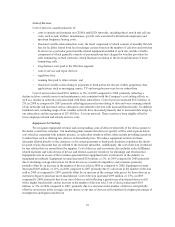Sprint - Nextel 2008 Annual Report Download - page 50
Download and view the complete annual report
Please find page 50 of the 2008 Sprint - Nextel annual report below. You can navigate through the pages in the report by either clicking on the pages listed below, or by using the keyword search tool below to find specific information within the annual report.property, plant and equipment. These studies take into account actual usage, physical wear and tear, replacement
history and assumptions about technology evolution. When these factors indicate that an asset’s useful life is
different from the previous assessment, we depreciate the remaining book values prospectively over the adjusted
remaining estimated useful life. Depreciation rates for assets using the group life method are revised periodically
as required under this method. Changes made as a result of depreciable life studies and rate changes generally do
not have a material effect on depreciation expense.
Long-lived assets are reviewed for impairment whenever events or changes in circumstances indicate
that the carrying amount may not be recoverable. Long-lived asset groups were determined based upon certain
factors including assessing the lowest level for which identifiable cash flows are largely independent of the cash
flows of other groups of assets and liabilities. If the total of the expected undiscounted future cash flows is less
than the carrying amount of our assets, a loss is recognized for the difference between the estimated fair value
and carrying value of the assets. Impairment analyses, when performed, are based on our current business and
technology strategy, views of growth rates for our business, anticipated future economic and regulatory
conditions and expected technological availability. During 2009, we tested long-lived assets in our Wireless
segment for recoverability and, based on our estimate of undiscounted cash flows, determined the carrying value
to be recoverable. Our estimate of undiscounted cash flows exceeded the carrying value of these assets by more
than 10%. If we continue to have operational challenges, including obtaining and retaining subscribers, future
cash flows of the Company may not be sufficient to recover the carrying value of our wireless asset group, and
we could record asset impairments that are material to Sprint’s consolidated results of operations and financial
condition.
In addition to the analyses described above, certain assets that have not yet been deployed in the
business, including network equipment, cell site development costs and software in development, are periodically
assessed to determine recoverability. Network equipment and cell site development costs are expensed whenever
events or changes in circumstances cause the Company to conclude the assets are no longer needed to meet
management’s strategic network plans and will not be deployed. Software development costs are expensed when
it is no longer probable that the software project will be deployed. Network equipment that has been removed
from the network is also periodically assessed to determine recoverability. If we continue to have challenges
retaining subscribers and as we continue to assess the impact of rebanding the iDEN network, management may
conclude in future periods that certain CDMA and iDEN assets will never be either deployed or redeployed, in
which case non-cash charges that could be material to our consolidated financial statements would be recognized.
Evaluation of Goodwill and Indefinite-Lived Intangible Assets for Impairment
Goodwill represents the excess of purchase price paid over the fair value assigned to the net tangible and
identifiable intangible assets of acquired businesses. Sprint evaluates the carrying value of goodwill annually or
more frequently if events or changes in circumstances indicate that the carrying amount may exceed estimated
fair value. Our analysis includes a comparison of the estimated fair value of the reporting unit to which goodwill
applies to the carrying value, including goodwill, of that reporting unit.
We regularly assess whether any indicators of impairment exist, which requires a significant amount of
judgment. Such indicators may include a sustained significant decline in our share price and market
capitalization; a decline in our expected future cash flows, a significant adverse change in legal factors or in the
business climate; unanticipated competition; the testing for recoverability of a significant asset group within a
reporting unit; and/or slower growth rates, among others. Any adverse change in these factors could result in an
impairment that could be material to our consolidated financial statements.
The determination of the estimated fair value of the wireless reporting unit and other assets and
liabilities within the wireless reporting unit requires significant estimates and assumptions. These estimates and
assumptions primarily include, but are not limited to, the discount rate, terminal growth rates, operating income
before depreciation and amortization (OIBDA) and capital expenditures forecasts. Due to the inherent
uncertainty involved in making those estimates, actual results could differ from those estimates. The merits of
each significant assumption, both individually and in the aggregate, used to estimate the fair value of a reporting
unit, as well as the fair values of the corresponding assets and liabilities of the reporting unit, are evaluated for
reasonableness.
48
























